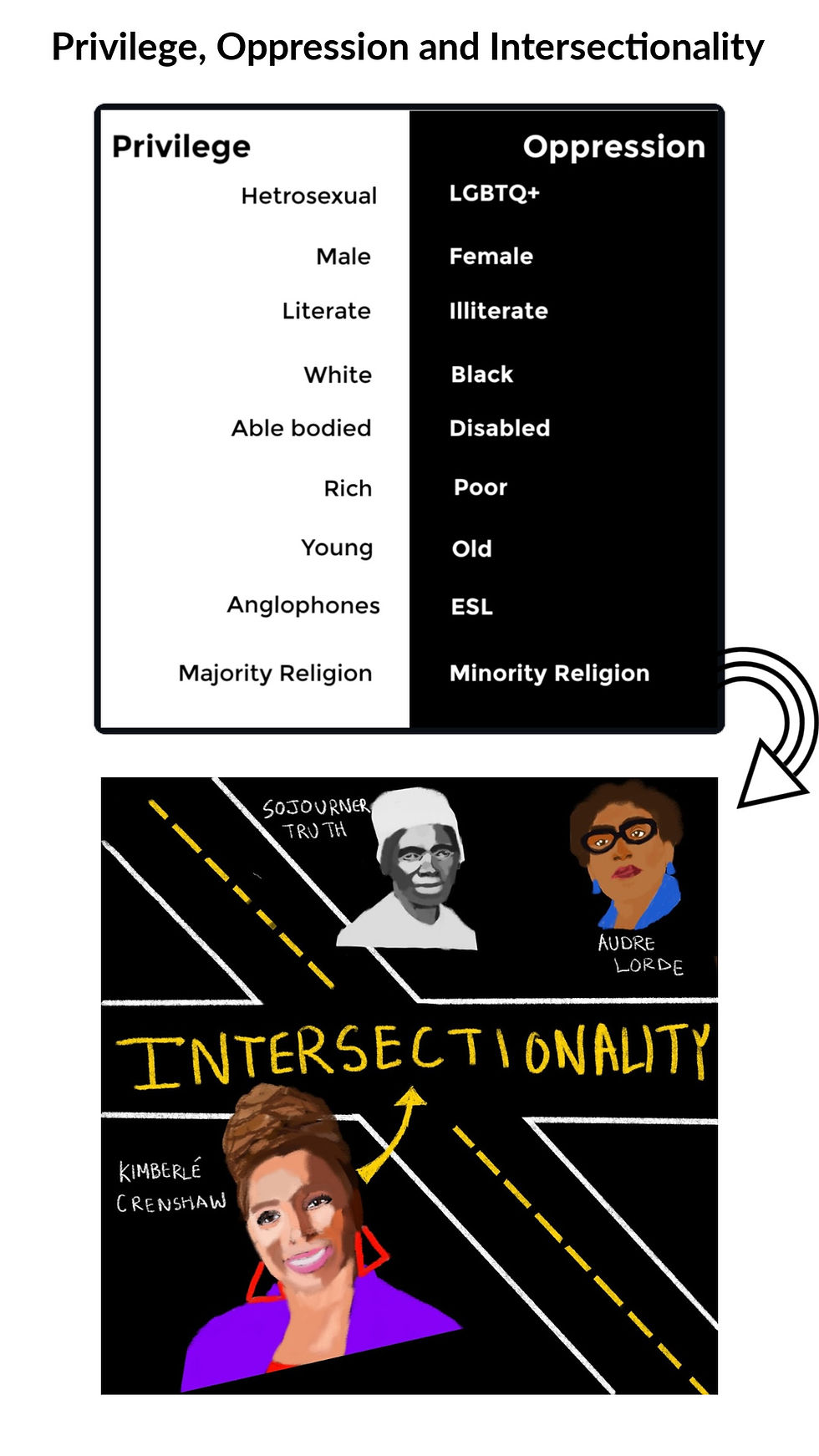Life at the intersection: Privilege, Oppression & Intersectionality
- Kriti - 17 , Chicago USA

- Jun 6, 2020
- 4 min read
Updated: Jun 9, 2020
Kriti Sarav, 15yo, Chicago, USA
In order for us to be financially literate, we need to understand ongoing global events.
Social injustice has been prevalent throughout human history, but in recent weeks there has been a lot of attention on racism. People from all over the world have come together to stand in solidarity for Black Lives Matter and Say Her Name. Also, in light of Pride month, I believe it would be a good time to talk about Privilege, Oppression and Intersectionality.
Privilege
Privilege is defined as “unearned access to resources and social power that are only available to some as a result of their advantaged social group membership” (Adams, Bell, & Griffin, 2007). In the US, many argue the most privileged person is an able-bodied, middle-aged white male, who is Christian, straight and is economically secure. This perception of the ideal identity dominates everything else.
Oppression
Oppression is defined as “a system that maintains advantage and disadvantage based on social group memberships and operates, intentionally and unintentionally, on the individual, institutional, and cultural levels” (Adams et al., 2007). If you do not conform to any of the acceptable identities, then you are oppressed.
But it’s hard to conform to what is acceptable. Why? Because how can you change what you were born with? How can you change your heritage? How can you change your upbringing? And then society puts all these ‘isms’ on you (racism, sexism, heterosexism, classism etc.), confines you into these “identity boxes” and oppresses you.
Intersectionality
Intersectionality I believe it is an important concept to address.
In simple terms, intersectionality is many levels of the discrimination people face, when much of their social identifiers are in the oppressed category.
In 1851, a famous abolitionist, Sojourner Truth, alluded to this idea in her speech, “Ain’t I a Woman.” Sojourner Truth, a former slave delivered this powerful, riveting speech about the intersection of black rights and the feminist movement. Sojourner explained that assuming a black woman and white woman share similar experiences is not true. Yes, they are both women, but one due to melanin in her skin has a completely different life and human experience in society.
Also I remember reading this poem in school, “Who Said it was Simple”. It was written by Audre Lorde, a black lesbian poet, in 1973. I think what drew me to the poem is she talks about how you cannot dismiss any one part of her, she comes as a whole package. She also brings up the topic of how a movement like Feminism will advocate for one social reform in society but oppress/ dismiss the other movements such as Racism.
So in the 1970s and 1980s many black activists started to think about multiple oppression. In 1989 Kimberlé Crenshaw coined the term “Intersectionality”.
This is how she explains Intersectionality:
Pretend you are standing at an intersection of two roads, constructed by social identifiers such as race and gender. The traffic is the different practices and policies in society that discriminate against you. But if an accident happens, vehicles can hit you from multiple directions. This can break you.
This is what Sojourner Truth was implying too. A black woman will be hit from more directions (sexism, racism, class, etc) than a white woman.
For example, a female immigrant, who is a person of color has 3 areas where she can be oppressed. For someone observing her, it may seem like a simple addition, she is oppressed in 3 categories. But her experience standing at this intersection is not a simple addition, it has a compounding effect on her life, experiences, opportunities, and will affect her posterity.
And, this is what Audre Lorde was implying as well. She is complex because of her many identifiers, so “Who said it (Intersectionality) was Simple?”
So without Intersectionality, movements such as the Feminist movement often fails to embrace women of color, the LGBTQ community and disabled people, while only focusing on white women.
To sum it up
Intersectionality helps us understand the problem and better conceptualize privilege and oppression. But it is not the solution.
Although it does allow us to understand the different identifiers in society, it categorizes us into boxes, yet again.
What needs to happen is that regardless of what intersection you stand at, this traffic (practices and policies that discriminate against you) should not crash into you.
Many people may not be fully aware of their privilege. It's like you can never know happiness without experiencing sadness, so you can never know your privilege without experiencing some form of oppression.
That’s why we all need to step into other people’s shoes and educate ourselves about lives that are not necessarily like our own. By making an active effort to see things from the perspective of others, you will not necessarily get rid of your privilege but be aware of it.
Then we will be able to stand in solidarity and show our support to those who do not share the same ‘privileges’ like us.

Citations:
Bell, L. A. (2007). Theoretical foundations for social justice education. In M. Adams, L. A. Bell, & P. Griffin (Eds.), Teaching for diversity and social justice (p. 1–14). Routledge/Taylor & Francis Group.
Crenshaw,K. (1989). U. Chi. Legal F. 139 (1989)
Demarginalizing the Intersection of Race and Sex: A Black Feminist Critique of Anti-discrimination Doctrine, Feminist Theory and Antiracist Politics.
.jpg)



Comments